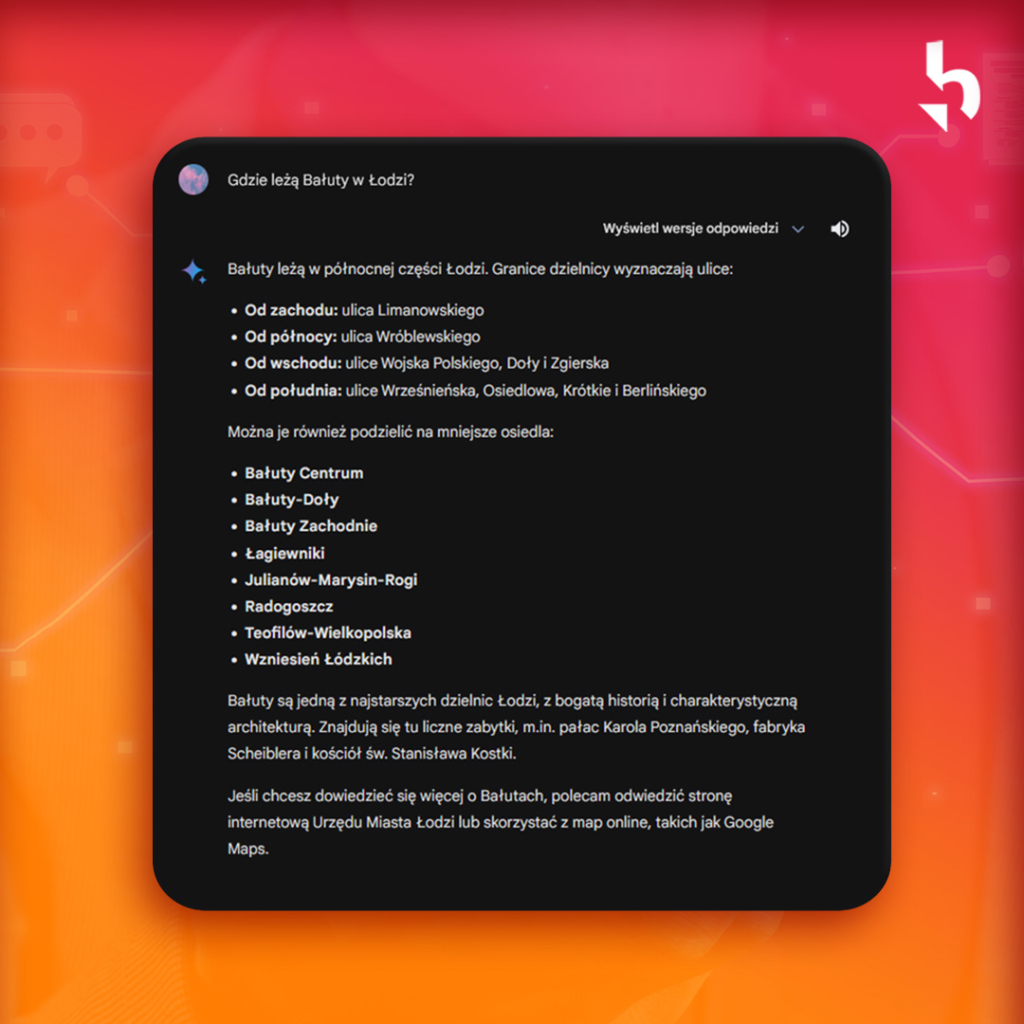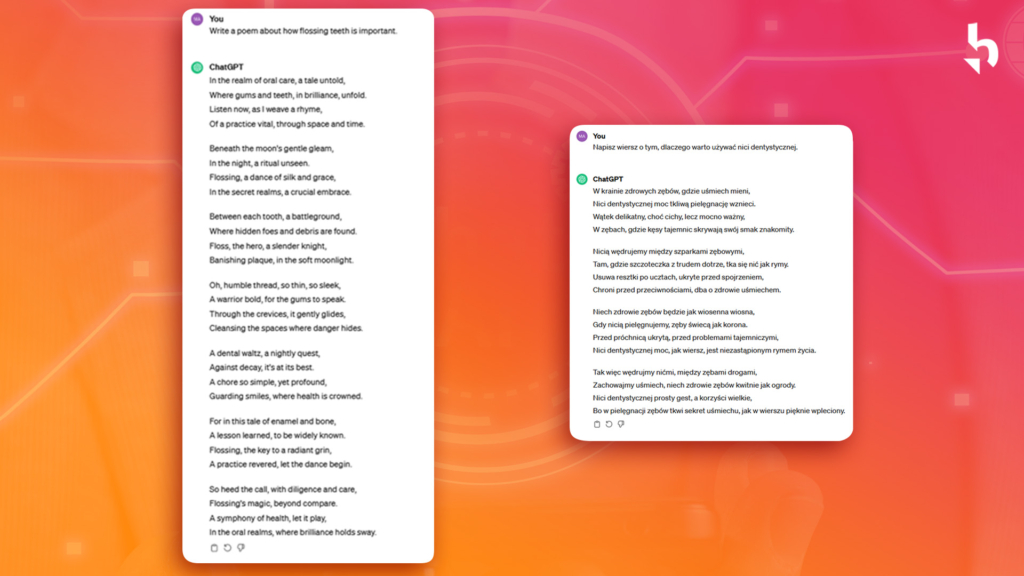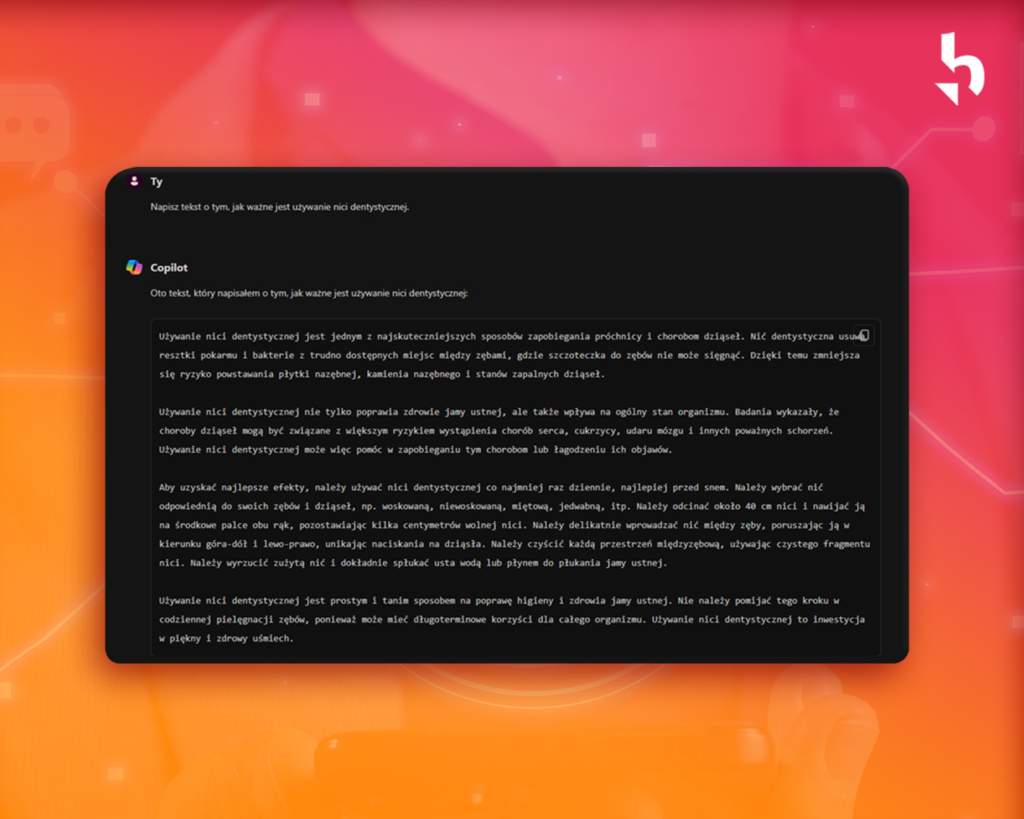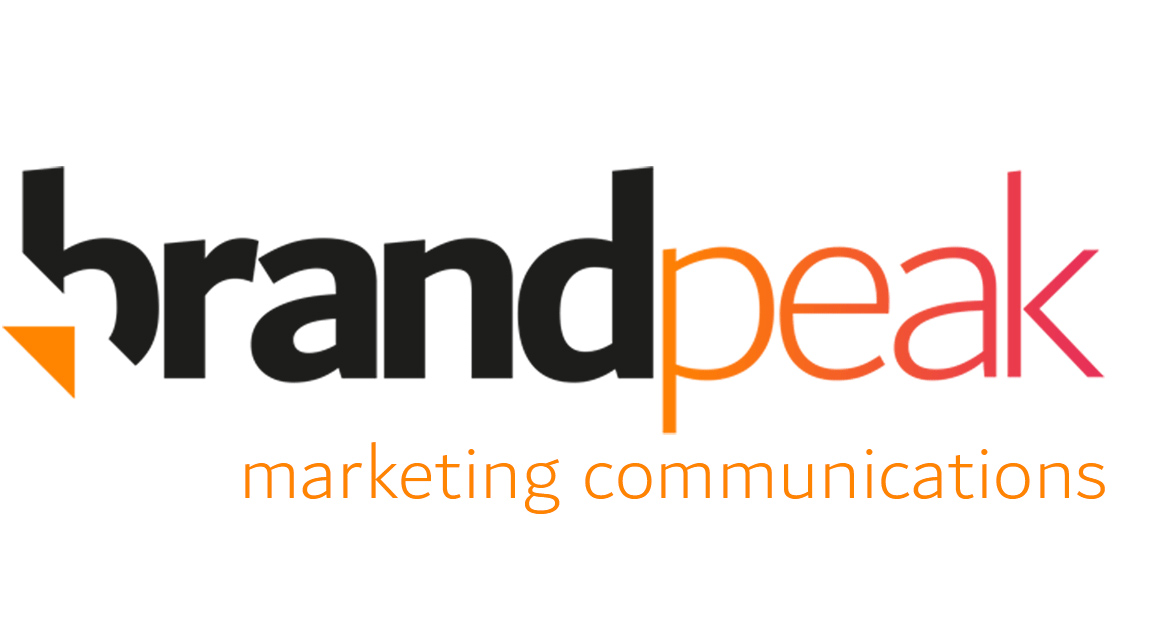AI writing. How can artificial intelligence be used effectively to create content?
- 21 February 2024
-
Mariusz Jaroń

Machine learning, natural language processing, digital transformation, artificial intelligence – until recently it might have seemed that they had little to do with content marketing. Today, in the era of increasingly dynamic development of technology, it is impossible to ignore them – especially since they can provide significant support in the creation of broadly understood content. But how to use AI tools wisely in content marketing and content creation? In this article, I have some practical tips that should help you.
Although the term “artificial intelligence” is not new and many companies used tools based on broadly understood AI, it became established in public discourse around November 2022 – because that’s when the world heard about ChatGPT-3, i.e. the public language model , provided by OpenAI. ChatGPT resembles an instant messenger in which the user, using prompts (commands), orders Artificial Intelligence to perform specific tasks in the area of content generation.
These include creating lists, cover letters, CVs, summaries of submitted texts, translating complex phenomena, writing codes, product descriptions, and even writing poems and song lyrics – in short, everything that can be reduced to creating content – on social media and beyond.
Artificial intelligence – a boom that changed reality
The tool, using natural language processing, was characterized by flexibility, universality and speed of operation, because – depending on the command issued, ChatGPT was able to write a text of 3-4 thousand characters in a short time. Whether these texts are good, creative and precise is a separate issue that we will discuss in the following paragraphs. However, this does not change the fact that the OpenAI tool, in a sense, initiated the artificial intelligence boom.
At the same time, it forced other technological giants to work on developing their own tools, such as Bard (today Gemini) from Google or Copilot from Microsoft (it is worth noting that Microsoft is one of the main investors in OpenAI). Over the following months, OpenAI released ChatGPT-4, which is – in short – a faster, more efficient, smarter, more functional, but at the same time paid version of its tool. And that’s it for the basic historical outline. After all, it is not the timeline itself that is most important here.
Artificial intelligence – concerns
Among the numerous sighs of delight and shouts of excitement, however, one could hear questions and concerns whether such a dynamic development of generative AI does not mean that what we all fear so much will come: that Artificial Intelligence and technology will replace humans and take away from us – marketers, copywriters and graphic designers and many other specialists – work? To be clear: these were not isolated voices.
According to Deloitte data, 42% surveyed Poles aged 18 to 65, who are aware of the existence of AI, are afraid that its use may translate into a decrease in the number of jobs. 28 percent respondents of the same study believe that Artificial Intelligence is able to take over some of the tasks they perform. 38 percent expresses concern that they may be replaced by AI in the future.
Let’s stay with the Deloitte report for a moment, but let’s take a look at other data that shows that:
- 80% people aged 18-24 used AI-based solutions;
- 84% do it. students and 64 percent working people;
- 40% users use tools based on generative artificial intelligence at least once a week, and 51 percent – at least once a month.
So if you’ve landed here, there’s a good chance you’ve used or still use AI. Welcome to the club! I have been using AI myself practically from the very beginning of its boom in many different ways, and the experience gained led me to several observations that helped me better use and understand generative artificial intelligence and use it to prepare better, more qualitative and valuable content marketing texts.
It’s just a tool
Let’s get the most important thing straight: AI-based tools, although increasingly advanced and functional, are just tools. This is the issue that organizes and “sets” the entire discussion about artificial intelligence.
ChatGPT, Copilot or Google’s Gemini do not have magical properties – and in a sense, they do not even have “human” properties. No matter how advanced generative AI is, it will not replace the human factor for a long time – or perhaps -. It is absolutely necessary to write clear, understandable and high-quality texts. It consists of creativity, the ability to think outside the box, feel emotions, formulate non-obvious associations, better understand your audience and interact with them. And finally: a sense of humor.
Not to pay lip service: here’s a joke from Microsoft’s Copilot 😉

Artificial intelligence and text generation. The principle of limited trust
The second observation is strongly and directly related to the first one. Many people who start their adventure in using generative artificial intelligence for writing forget that it is only a tool. It is intended to support the writer in completing the task ahead of him… However, it is worth remembering that it is the prompting user who is responsible for the final shape of the text. However, excessive trust in artificial intelligence carries many risks.
When generating content, avoid plagiarism!
It’s no secret that AI writing tools can generate content that is similar or identical to the sources they are based on. At the same time, they do not always and do not know how to mark them correctly. This may lead to an unauthorized person appropriating someone else’s work, i.e. plagiarism, which – let me remind you – is a crime.
Let’s face it: being accused of plagiarism is not something you, your company or your employer dream of. Not to mention the material (financial claims) and intangible (loss of trust and credibility) consequences of such an act.
The conclusion is clear: mindlessly copying 1:1 content “spit out” by any AI-based generator is never a good idea. It is worth treating such a text as a synthesis of information or a starting point or inspiration for preparing the text. Never as ready-to-publish material. Of course, texts generated by AI can also be “passed” through anti-plagiarism software… but here we can smoothly move on to the next point.
Lack of originality
Let’s assume that the text you commissioned AI to prepare has been thoroughly verified by you. Everything is correct – the text has passed three positive “tests” in the anti-plagiarism program. It is based on reliable sources. Provides data consistent with the actual situation. So there’s no need to worry about using it… but is it really?
If you use any of the AI-based tools – for example the free ChatGPT 3.5 – you know that they can generate somewhat boring, conservative and safe content, full of platitudes and generalities. To tell you the truth, even an average eye can already see the features characteristic of ChatGPT (specific, formal way of constructing answers, standard summaries, dividing statements into points and Frequently Starting Each Word with a Capital Letter, Just Like in This Fragment).
Do you want to use AI to create captivating, engaging, exciting and – above all – original content, not clichéd, generic wordplay? I have some advice for you. I will refer to what I mentioned earlier: do not copy content produced by artificial intelligence 1:1. There’s a good chance that your competitors are already doing it… And if you do it too, you won’t stand out from them.
Don’t take AI-generated “input” literally. Saturate such material with the human touch element. Give it your own style – use emotions, personal observations, humor, and non-obvious comparisons. Or maybe even wink at the reader (and I don’t mean the emoticon 😉).
Inaccuracy
Generative artificial intelligence can also be unreliable in terms of broadly understood accuracy. It’s not only about stylistic errors (sentences that don’t follow each other or problems with inflecting some words) and substantive errors (confusing facts or even making up sources, commonly known as hallucinations), but also about not understanding some queries and consistently repeating the same mistakes. It is therefore worth – I repeat – carefully verifying the presented data. Failure to do this and uncritically relying on outdated information undermines your credibility and authority. I repeat: Yours, not the tool you based it on.

Lack of consistency
AI-based writing tools may also have difficulty matching tone, style, format, or communication purpose. As a result, you do not take into account nuances or context that are important to you. For example: ChatGPT in Polish has, to put it mildly, problems with more non-standard and more stylistically complex forms. Let’s take a poem as an example. It is worth comparing it with material prepared in English. The difference in quality is visible to the naked eye.

The better the prompt, the better the “final material”
Formulating precise expectations and needs can be crucial in achieving the intended goal. This sounds like a universal rule that can be applied to many areas of life. However, let’s stick to the area of creating content based on artificial intelligence. 😉
The prompt entry field in any advanced generative AI tool is a blank slate. First of all, because we can enter what we want. Secondly, what we put on this blank card determines the shape of the output material. In other words: the quality of the text generated by AI depends on the quality of the command itself and the guidelines it receives.
Brief artificial intelligence
When working with any tool – whether ChatGPT, Copilot, Jasper or Gemini – it is worth “briefing” it: not only issuing a command, but also writing down what its purpose is, who it is addressed to, and what form it should have. As we established almost at the very beginning – AI writing tools do not have magical properties and cannot read minds.
Even the most advanced models will not guess what your exact expectations are if you do not communicate them yourself, and this in turn may lead to the preparation of content that is not tailored to your needs, unrelated to your motive, goal or target group, and thus – waste Your time and energy. The lack of a thorough brief for AI can also make what you wanted to convey or explain “blurred” in the text and become elusive, frustrating not only you, but also readers who are unsuccessfully looking for answers to their questions.
Examples of a more and less precise brief
How to avoid such problems? Below are two more examples. One of them is based on a general, imprecise prompt, while the other was written based on slightly more precise guidelines. The effect of the first one is simply a block of text without any specific structure, titles or subheadings; I actually don’t know how I could use it.

In the case of the second one, the statement is more closely tailored to the needs I have identified. Of course, the end result does not fully satisfy me, but it cannot be denied that it is creative and “reads” into my brief.

Give feedback and communicate
Also remember that if I am not satisfied with the text, I can always provide the AI with appropriate feedback. For example, ask for an alternative proposal, if the text does not sufficiently meet my needs, pay attention to possible errors. Or simply commission a continuation of the text if – in my opinion – it has not exhausted the topic.
When “prompting” AI, you should bear in mind that outlining guidelines and needs may often require time and effort. However, I assume that it is worth doing it for a satisfactory effect. After all, if AI helps me, then I – by helping AI – help myself, right?
Content marketing and artificial intelligence. Learn with the help of AI
Tools based on language models and trained on large text data sets allow the generation of huge amounts of text. So in a sense and to simplify things… they are constantly learning and constantly being improved. In my opinion, the same should apply to users who use such tools: they should also learn all the time. Working with AI while writing can also be a source of knowledge, competences and interesting experiences. It can make you a better, more effective and more flexible content creator.
I will repeat once again: using generative artificial intelligence in writing, which involves thoughtless and uncritical copying of content, is a mistake. This is detrimental both to the AI itself and to you as a content creator. Failure to learn from AI can lead to stagnation that stops you from growing as a content writer. You don’t challenge yourself, explore new ideas or test new styles, formats and conventions. This in turn… causes frustration.
So use AI to learn. analyze strong and weak content based on the prompts you have prepared. Compare it with your own original content. Draw conclusions and pay attention to what AI does better than you. Look at what you are better at. You can also use AI to evaluate your own content marketing texts and follow its suggestions and observations. Or on the contrary: to reinforce the belief that humanly speaking he is simply… wrong.
The future of AI and the future of content marketing. Should you be afraid of artificial intelligence? Can it replace a human?
I can only speak on my own behalf (although something tells me that my observations will be shared by many people). I’m not an uncritical fan who idolizes artificial intelligence. I realize that a bad, greedy approach to this tool can do a lot of harm to civilization. Many of the concerns related to it are justified. However, I do not want to explore this topic because it is a complex and ambiguous issue in which I do not consider myself an expert.
However, I will adopt the narrow perspective of a person who works with text and deals with content marketing on a daily basis. For me, the measure of broadly understood progress is that it is simply easier and easier for its beneficiaries. Whatever we say about it – artificial intelligence and its development are undoubtedly part of progress. When used wisely, it can make work easier and help authors create content that is better, more engaging and exciting for audiences. I emphasize once again – it is supposed to facilitate and help, not replace or replace.
Of course – I also take into account the scenario in which artificial intelligence becomes more and more perfect. That he can imitate the above-mentioned human factor better and better – e.g. humor, creativity, the element of the so-called emotional intelligence and the ability to think outside the box – and therefore, more and more texts will be created using AI. But does this mean that the human role will lose importance? In my opinion, on the contrary – it may redefine its role, and the role of copywriting and content marketing specialists is evolving towards. Will it be so? Maybe. If so, it is even more worth making friends with AI, getting used to it and learning how to use it wisely.
Finally, I would like to highly recommend a very interesting text by my friend, Gosia Tkaczenko. It focused on Artificial Intelligence, but in the context of the graphic arts profession and its future. If you haven’t read it yet, I highly encourage you to read it.
Zobacz, co jeszcze u nas słychać
Contact us
We will tailor actions to your needs and demonstrate how effective marketing and planned communication impact brand perception, image, and business sales. Feel free to ask what specific steps we can take for you.

Brandpeak
Biurowiec Rent Poland
ul. Zbąszyńska 4, 91-342 Łódź, Poland
Brandpeak — social media, internet marketing and public relations agency
Brandpeak is an agency specializing in social media, internet marketing, and public relations. We emphasize a unique blend of experience and knowledge. Our specialists meticulously plan and successfully execute campaigns and projects in internet marketing, digital PR, and social media. We utilize various online marketing tools, such as content marketing, influencer marketing, performance marketing, PPC, and email marketing.
Our services also include social media management and advertising. We excel in managing social media platforms, including Facebook, Instagram, and LinkedIn, which our satisfied clients can attest to! Through our efforts, we aim to build brand awareness, support the creation of strong brands, shape and maintain a positive image, and uphold a favorable reputation.
We achieve this through PR campaigns, analysis, building and nurturing media relationships, and managing press offices for our clients. We don’t fit neatly into a single category like a PR agency, social media agency, advertising agency, or creative agency. We prefer to think of ourselves as a comprehensive marketing agency that tailors marketing tools based on the specific goals we aim to achieve: improving brand image, increasing brand awareness, boosting sales, reaching new customers, and more. We understand the importance of these goals and how they contribute to business growth.
This holistic approach makes us the best marketing agency serving clients in Warsaw, Łódź, Poznań, Gdańsk, Kraków, Katowice, and Wrocław. Social media agency. PR agency. Marketing agency. Visit brandpeak.pl/en for more information.





